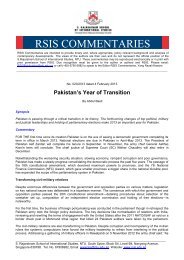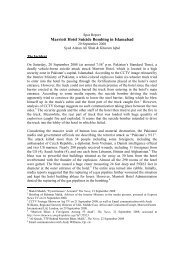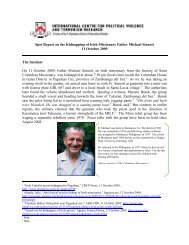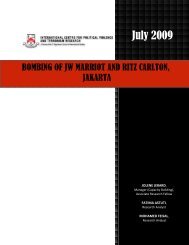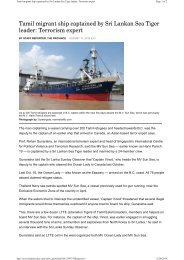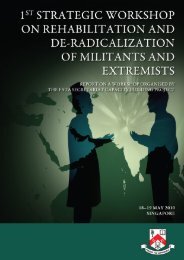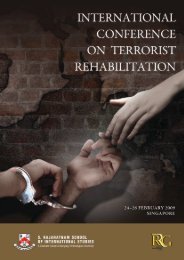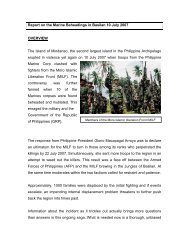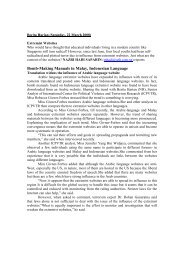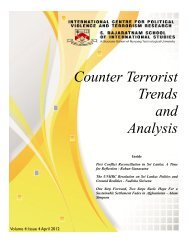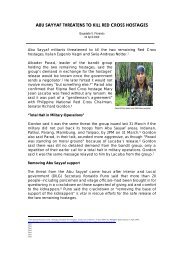Peace and Security Review, Vol.1 No. 2 - International Centre for ...
Peace and Security Review, Vol.1 No. 2 - International Centre for ...
Peace and Security Review, Vol.1 No. 2 - International Centre for ...
Create successful ePaper yourself
Turn your PDF publications into a flip-book with our unique Google optimized e-Paper software.
Taharudin Ampatuan Philippines’ Counter Insurgency <strong>and</strong> Terrorism 61<br />
alienated the Moro population making future peace ef<strong>for</strong>ts difficult. So while<br />
there was a unified comm<strong>and</strong>, there was no political will to implement<br />
necessary re<strong>for</strong>ms.<br />
Post Martial Law<br />
Until the attack <strong>and</strong> burning of a progressive Christian town of Ipil, Zamboanga<br />
Sibugay in 1995, perpetrated by the ASG, the comm<strong>and</strong> structure of the AFP<br />
was seen to be effectively addressing the patches of conflict posed by the MILF<br />
(Islamists). However the emergence of radical Islamist Abu Sayaf Group <strong>and</strong><br />
its alleged connections with trans-national terrorist groups such as Al-Qaeda<br />
<strong>and</strong> the Indonesian Jemaah Islamiyah put the security infrastructure of Philippine<br />
government to test. The new operational threat posed by deliberately targeting<br />
civilians caught the government off-guard. The Abusayaf activities, which<br />
crossed the line between political violence <strong>and</strong> criminality, challenge the coordinative<br />
structure of the Philippine government. The Philippine National Police,<br />
which has been made independent of the AFP <strong>and</strong> placed under the newly<br />
created Department of Interior <strong>and</strong> Local Government (DILG) in 1998, proved<br />
to be no match <strong>for</strong> the highly experience, well armed Moro rebels. The breaking<br />
of the unified comm<strong>and</strong> structure did not help matters.<br />
This latter problem was a reversion to the past. The military, police, <strong>and</strong><br />
local government all had problems coordinating responses to the crisis. For<br />
instance in the burning of Ipil Town by the ASG, under the existing arrangement,<br />
the Police is supposed to be responsible <strong>for</strong> addressing act of terrorism under<br />
the <strong>Peace</strong> <strong>and</strong> Order Council framework. 37 However, since the burning of<br />
Ipil town resulted in deaths <strong>and</strong> disaster, this incident could be seen as a<br />
National Disaster Coordinating Council m<strong>and</strong>ate, 38 which is headed by the<br />
Department of National Defense, whose operating arm is the Armed Forces<br />
of the Philippines. These problems can only be solved through legislation,<br />
however, none of the existing agencies wants to initiate re<strong>for</strong>ms as they could<br />
lose responsibility <strong>for</strong> areas <strong>and</strong> hence turf. Thus the confused status quo<br />
remains.<br />
In the Martial law period, the Philippine National Police was under the<br />
Armed Forces of the Philippines; hence deployment of police to support<br />
insurgency campaign was easier. After the Martial Law, the Philippine Police<br />
operational supervision was transferred to the Department of Interior <strong>and</strong><br />
Local Government. This is further complicated by the Local Government<br />
37 Executive Order_309 “National <strong>Peace</strong> <strong>and</strong> Order Council <strong>and</strong> Republic Act 7260,” Local<br />
Government Code of 1998.<br />
38 PD 1566, “Philippine Disaster preparedness program,” issued o n 11 June, 1978.<br />
<strong>Vol.1</strong>, <strong>No</strong>.2 2008 pp.49-76




